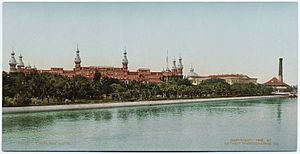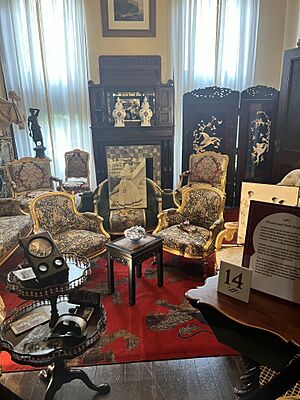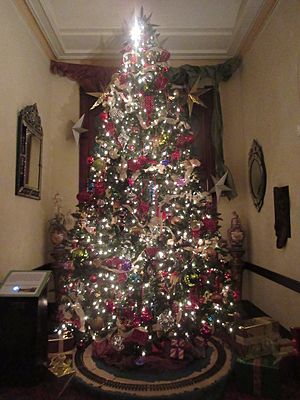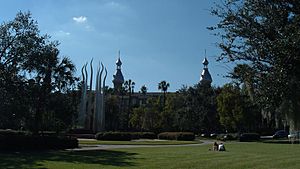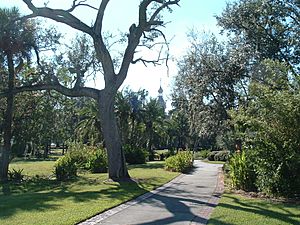Henry B. Plant Museum facts for kids
|
Tampa Bay Hotel
|
|
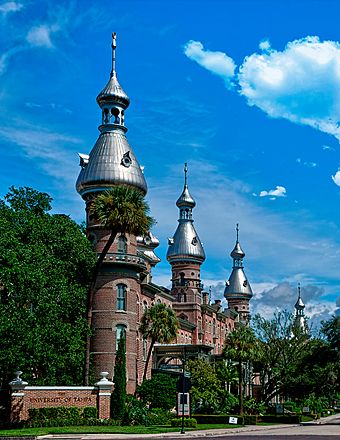 |
|
| Location | 401 W. Kennedy Blvd., Tampa, Florida |
|---|---|
| Area | 4.5 acres (1.8 ha) |
| Built | 1888–1891 |
| Architect | John A. Wood |
| Architectural style | Moorish Revival |
| NRHP reference No. | 72000322 |
Quick facts for kids Significant dates |
|
| Added to NRHP | December 5, 1972 |
| Designated NHL | May 11, 1976 |
The Henry B. Plant Museum (often called the Plant Museum) is a cool place to visit in Tampa, Florida. It's located in a part of Plant Hall on the University of Tampa campus. This amazing building was once a super fancy hotel called the Tampa Bay Hotel.
A rich railroad owner named Henry B. Plant built the hotel. It opened way back on February 5, 1891. The museum today shows what life was like during the "Gilded Age" (a time of great wealth and change). It also teaches about the hotel's role during the Spanish–American War. The museum is set up like a historic house, so you can see how things looked when guests stayed there.
The Tampa Bay Hotel was designed by an architect named J.A. Wood. He also designed other important buildings in Florida and Georgia.
Contents
A Look Back: The Tampa Bay Hotel's Story
Building a Dream Hotel
The Tampa Bay Hotel was built by Henry B. Plant, a powerful railroad owner. Construction took three years, from 1888 to 1891, and cost over $3 million! This was a huge amount of money back then. It was the most important of eight hotels Plant built along his railroad lines.
The hotel was enormous, covering 6 acres and stretching a quarter-mile long. It had some amazing features for its time:
- Florida's first elevator, which still works today! It's one of the oldest working elevators in the country.
- The 511 rooms and suites were the first in Florida to have electric lights and telephones.
- Most rooms even had private bathrooms with full-size bathtubs.
Staying here was expensive, costing $5 to $15 a night. Other hotels in Tampa at the time charged only $1.25 to $2.00. The building was made of strong concrete and steel, so it was advertised as being fireproof.
Hotel Grounds and Design
The hotel grounds were huge, about 150 acres. They included:
- A golf course
- A bowling alley
- A racetrack
- A casino
- An indoor heated swimming pool
In total, there were 21 buildings on the property. Henry Plant chose a special design called Moorish Revival architecture. This style looked exotic and European, which was popular with the wealthy travelers of that time. The hotel has six tall towers called minarets, four small domes called cupolas, and three large domes. All of these are decorated with fancy "Victorian Gingerbread" trim. These features were restored in the early 1990s to look like new.
From 1889 to 1891, Plant traveled all over Europe. He bought tons of beautiful art and furniture to decorate the hotel. So much art arrived that some had to be sold because there wasn't enough space! Today, the museum wing still has many of these original items. You can see fancy bronze statues, furniture, clocks, and paintings. There's even a special vase that was a gift from the Emperor of Japan.
Famous Guests and War Time
From 1891 to 1930, thousands of people stayed at the Tampa Bay Hotel. Many were famous celebrities and important political figures.
When the Spanish–American War started, Henry Plant convinced the U.S. military to use his hotel as a base. Generals and high-ranking officers stayed there to plan their strategies. Soldiers camped out on the hotel's large grounds. Colonel Theodore Roosevelt and his famous "Rough Riders" also stayed at the hotel. Roosevelt had a suite and led his men in practice battles on the grounds.
Other famous visitors included:
- Actress Sarah Bernhardt
- Red Cross founder Clara Barton
- Writer Stephen Crane
- The Queen of the United Kingdom
- The Prince of Wales
- Future Prime Minister Winston Churchill
- Musician Ignacy Paderewski
Even baseball legend Babe Ruth stayed at the hotel later on. He signed his first baseball contract in the hotel's Grand Dining Room. In 1919, he hit his longest home run during a practice game right next to the hotel!
Hotel Closes, University Opens
The Tampa Bay Hotel closed its doors in 1930. This was because of the Great Depression, which meant fewer people could afford to travel. The grand hotel sat empty for three years.
Then, in 1933, something new happened! The Tampa Bay Junior College was allowed to move into the hotel. The old suites became classrooms, labs, and offices. Because the hotel had so much space, the college grew and became the University of Tampa.
The city of Tampa also created the Tampa Municipal Museum to save the hotel's original look. This museum shared the building with the new university. In 1941, the city leased the building to the University of Tampa for 99 years for just $1.00 a year! The museum kept its own section. In 1974, the Tampa Municipal Museum was renamed the Henry B. Plant Museum.
The Plant Museum Today
Today, the south wing of Plant Hall is still dedicated to showing off the amazing history of the Tampa Bay Hotel. It's also used by the University of Tampa for offices and classrooms.
The museum has many rooms filled with real items from the old hotel. Many of these were bought by Mr. and Mrs. Plant themselves during their trips to Europe. The displays show what suites, dining rooms, and even war-time life looked like. It's like stepping back in time!
You can take a guided tour with a museum guide or listen to an audio tour. There's also a video called The Tampa Bay Hotel: Florida's First Magic Kingdom. All these help you imagine what life was like in historic Florida.
Fun Events at the Museum
The Plant Museum hosts many cool events throughout the year:
- Music in the Museum: Enjoy live classical music performances, just like guests did long ago. This happens on the third Thursday of every month.
- Fourth Friday: The museum offers free entertainment on its veranda from January to October.
- Sunday Tour: Take a guided tour, often followed by a special theater performance.
- Upstairs/Downstairs at the Tampa Bay Hotel: Actors play characters based on real guests or staff. They tell stories about their experiences in the hotel. This happens every Sunday from September to May.
- Picnic in the Park: Relax in the garden and try old-fashioned Victorian games like horseshoes and badminton. Actors in Victorian clothes are often there, and there's live music.
- Victorian Christmas Stroll: See how Christmas was celebrated in Victorian times with a walk through the decorated museum and gardens.
- The Great Gatsby Party: A fun 1920s-themed party with live music, food, and vintage car photo opportunities.
- An Eerie Evening at the Tampa Bay Hotel: In October, you can tour the museum by moonlight and hear spooky stories from the past.
The museum also sometimes holds antique evaluation events, like the ones you might see on TV shows.
Special Exhibitions
Besides its regular displays, the museum also has special exhibits. For example, "The Sportin' Life" showed old sports gear from the Gilded Age, like baseballs signed by Babe Ruth and old swimming suits. Other exhibits have featured royal designs and the history of the Red Cross during the Spanish-American War.
Plant Park and Hotel Grounds
The area around the hotel, now called Plant Park, once had many attractions. Today, you can still see some of them as part of the University of Tampa campus and the museum grounds.
Henry Plant Memorial Fountain
At the park's entrance is the "Henry Bradley Plant Memorial Fountain." Henry Plant's wife, Margaret, had it made in 1899 after he passed away. The fountain is called Transportation because it shows trains and ships, which were important to Mr. Plant's businesses. An eagle holding a strongbox is also part of the design. This was the logo for Plant's first company. The fountain was carved from stone and is the oldest public art in Tampa. It was restored in 1995.
Historic Cannons
Near the Hillsborough River, you can see two old cannons from Fort Brooke. This fort was an early military post from the 1800s where Tampa first grew. These cannons are from the American Civil War. They were part of a group of guns that protected Tampa Bay. In 1864, Union soldiers captured the fort and damaged the cannons so they couldn't be used. You can still see this damage today.
In the 1890s, Henry Plant moved two of these old cannons to the hotel grounds for guests to see. Later, they were placed on stone stands. Recently, a local group called Tampa's Rough Riders put the cannons on new carriages in Plant Park. A third cannon from Fort Brooke was lost for many years but was given away for scrap metal during World War II.
Another historic weapon faces Kennedy Boulevard in Plant Park. This large gun reminds us of Tampa's important role in the 1898 Spanish–American War. It points south towards Cuba. The sign says it's an eight-inch gun from Fort Dade, an old fort at the mouth of Tampa Bay. The original Fort Dade gun was placed here in 1927 but was also given away for scrap metal during World War II. After the war, a similar eight-inch gun from Fort Morgan, Alabama, was put in its place.
Plant Park's Past Zoo
Plant Park once had a small zoo along Biology Creek. This creek gets its water from an underground spring beneath the hotel. The zoo had a bear, an alligator, and many smaller animals. It was also known for its hundreds of squirrels and small lizards, which you can still see on campus today. The bear and alligator eventually moved to become the first animals at what is now the Lowry Park Zoo. The creek got its name "Biology Creek" because university students later used its water for science experiments.
The Shot Statues
Outside the hotel, you can find a statue called Au Coup de Fusil, which means The Shot. It shows two bronze hunting dogs that are suddenly alerted by the sound of a gunshot. These statues were made by a famous artist named Eglantine Lemaître in France in 1890. They were originally placed facing a small bronze squirrel, but this was later found to be incorrect. The squirrel was stolen, and the dogs were moved to their current spot. It's believed these dogs represent Mr. Plant's favorite hunting dogs. The hotel even had kennels where guests could get hunting dogs for their trips!
Friends of Plant Park
A group called the Friends of Plant Park (FoPP) works to help restore and take care of Henry B. Plant Park. They want to keep it as a beautiful garden for everyone to enjoy. They also research and share the park's Victorian history. This group started in 1993.
Since 1997, the FoPP has hosted an event called GreenFest to raise money. With these funds and other donations, they have helped restore the cannons, create a Victorian star-shaped garden, and build a replica of the original 112-foot flagpole. A large American flag from 1891 (with 45 stars) flies from this flagpole, along with the Florida state flag and the University of Tampa flag.
Awards and Recognition
The Plant Museum is recognized as an Accredited Museum by the American Alliance of Museums. This means it meets high standards for museums.
In 2012, the American Institute of Architects in Florida listed the University of Tampa's Plant Hall as one of "Florida Architecture: 100 Years. 100 Places."
The Henry B. Plant Museum, through Plant Hall, is also a U.S. National Historic Landmark. It was given this special title on December 5, 1972, under its original name, the Tampa Bay Hotel.
Gallery
See also
- Belleview-Biltmore Hotel
- Oglethorpe Hotel


